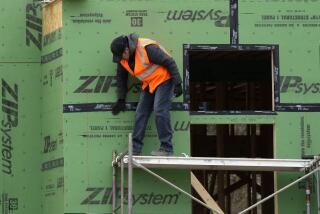When recession calls, job market gets message last
- Share via
WASHINGTON — The credit crisis has eased, but the bad news for the American worker may just be beginning.
Employers slashed jobs from one end of the economy to the other in October, pushing the unemployment rate to 6.5%. That’s the highest level in more than 14 years, and makes a deep recession a virtual certainty.
Almost no sector of the economy was immune to the decline. The biggest losses were in manufacturing and construction, but they were joined last month by big cuts in retail trade, financial services, and leisure and hospitality.
“It seems that firms had previously been cutting back employment only gradually, being cautious on hiring but not aggressive on firing,” said Nigel Gault, chief U.S. economist with consulting firm Global Insight. “They have now decided that the recession will be deeper than feared, and are acting more aggressively on firing, as they see demand for their products falling rapidly.”
Employers shed 240,000 jobs in October, and the toll in September was far worse than previously reported -- 284,000, up from an initial reading of 159,000.
The economy must normally create about 100,000 jobs a month just to keep pace with population growth. So far this year, the economy has shrunk by nearly 1.2 million jobs, the Labor Department said.
The latest cuts pushed the unemployment rate, which was 6.1% in September, almost half a percentage point higher in one month -- a sign that employers, facing slackened demand for their goods and services, were responding by cutting jobs.
Even two of the more robust employment sectors -- healthcare and government, which includes public servants such as teachers and police -- grew more slowly than in the past.
The last time the unemployment rate was so high was in the first quarter of 1994, when the economy was still struggling to recover from a recession.
The situation facing job seekers today is even worse when so-called discouraged workers are factored in -- an 11.8% overall unemployment rate in October, the Labor Department estimated, up from 11% in September. Officially the unemployment rate counts only those who have lost employment and are actively looking for new work; it does not include those who have stopped trying to find work or are working part time because they can’t find a full-time job.
Jared Bernstein, a labor economist with the Economic Policy Institute, noted that job losses were a “lagging” phenomenon. That is, unemployment tends to peak well after the economic shocks that cause it, and takes longer to abate even after the economy recovers.
He noted that the lag had lengthened in recent business cycles, with it taking roughly two years after a recession was over for the economy to regain the lost jobs.
“Employers often wait to be sure that the economy is really tanking before laying people off in earnest. And they want to be quite sure that consumers are back before they take on other workers,” Bernstein said. “Unfortunately, that lag has gotten a lot longer in recent years.”
Deteriorating conditions for U.S. workers are likely to intensify calls for Congress to pass another stimulus package.
“When the private sector engine stalls, the public sector engine needs to kick in,” Bernstein said.
A crucial factor in a recovery will be whether the financial shocks of the last few weeks and months have forced consumers to rethink their spending and saving habits.
For the first time in years Americans appear to be increasing their savings, said Ed Leamer, director of UCLA’s Anderson Forecast. That is probably wise for consumers whose assets have lost value and for workers fearful of losing their jobs, but it robs the economy of its major driver: About 70% of the nation’s gross domestic product is composed of consumer spending.
Leamer said that much of last spring’s stimulus payments went toward savings or paying down debt, and consumers are even more inclined now to save extra cash, not spend it.
The trick in devising a new stimulus, he said, would be to help consumers spend a little more in the short run while learning to increase their savings over time.
“It’s important not to panic the consumer,” Leamer said. “The short-term problem is too little spending and the longer-term problem is too much spending. . . . A nice little gradual increase in saving is what we should be doing.”
But, he said, the economy will not return to health until spending and saving are in better balance and Americans produce more and consume less.
“We’re in an economy that’s going to experience a structural adjustment,” Leamer said. “We need to convert some of our malls into factories.”
--
More to Read
Inside the business of entertainment
The Wide Shot brings you news, analysis and insights on everything from streaming wars to production — and what it all means for the future.
You may occasionally receive promotional content from the Los Angeles Times.










